Shimano’s 12-speed SLX M7100 groupset first launched back in 2019 alongside its more expensive and higher-performing XT M8100 sibling, which I awarded 4.5 stars out of 5.
At the time, we were impressed with the amount of trickle-down technology coming from the brand’s top-level XTR M9100 mechanical groupset, particularly the jump up to 12 cogs thanks to the Micro Spline freehub cassette.
Shimano SLX M7100 groupset headline figures:
- Total weight (including 165mm cranks with 32t chainring, rear derailleur, 116 link chain, 10-51t cassette and shifter): 1,864g
- Total price (including 165mm cranks with 32t chainring, rear derailleur, 116 link chain, 10-51t cassette and shifter): £398.94 / $394.94 / AU$734
SLX M7100 is touted as a go-anywhere, do-anything group that’s as versatile as it is durable. Like the rest of Shimano’s 12-speed drivetrains, it features a 10-51t cassette range, a Shadow+ rear derailleur with adjustable clutch, and boosting it up a level from Deore M6100 are Hollowtech II cranks, an aluminium largest cassette sprocket and several other refinements that reduce weight and improve shift quality.
SLX M7100 is an interesting proposition that doesn't offer a significant performance upgrade over Deore M6100 but costs over £100 / $100 / AU$100 more.
It’s significantly lighter though, tipping the scales at 155g less than a comparable Deore setup, with most of that weight saved is in the cassette, chain and crankset.
However, just considering performance, it’s hard to argue SLX’s case over Deore because it would also benefit from an XT M8100 shifter upgrade to improve shifting feel.
Shimano SLX M7100 groupset details and specifications
Although we went through the details of SLX M7100 when it launched, and have a detailed overview of the groupset’s weights, here are some top-line details on the groupset.
Shimano SLX FC-M7120 crankset with SM-CRM75 32t chainring specifications

Most notably, the FC-M7100 SLX crankset uses the same Hollowtech and Hollowtech II technology shared with Shimano's XT M8100 and XTR M9100 groupsets and is an upgrade over Deore M6100.
The technology means the crank arms are hollow-forged which, Shimano claims, improves stiffness while reducing overall weight.
The bottom bracket axle is integrated into the right-hand pedal crank furthering weight savings and increasing stiffness. Shimano also touts the system’s bearing sealing that uses an additional seal to improve its resistance against the elements.
The crank’s axle, like the rest of Shimano’s external bottom bracket cranks, is 24mm, which it says offers the perfect balance of stiffness, strength and weight.
The SLX cranks are available with or without a chainring, but SLX chainrings are available in 30t, 32t or 34t sizes. They use Shimano’s direct-mount system and are compatible with all other direct-mount Shimano 12-speed chainrings and cranks.

The supplied SM-CRM75 ring uses Shimano’s Hyperglide (HG) chainring with Dynamic Chain Engagement+ (DCE+) teeth profiling that’s specifically designed for 1× systems to improve chain retention. Both HG and DCE+ chainrings are designed to work exclusively with Shimano’s HG+ chains.
The cranks are available in 165mm, 170mm and 175mm lengths and a host of Q factors and bottom bracket widths to suit most modern bikes. Double chainring (2×) options are also available.
My test sample SLX FC-M7120 165mm crankset weighed 522g. The 32t SM-CRM75 chainring weighed 121g, taking the combined weight to 643g.
Shimano SLX SL-M7100-IR shifter specifications
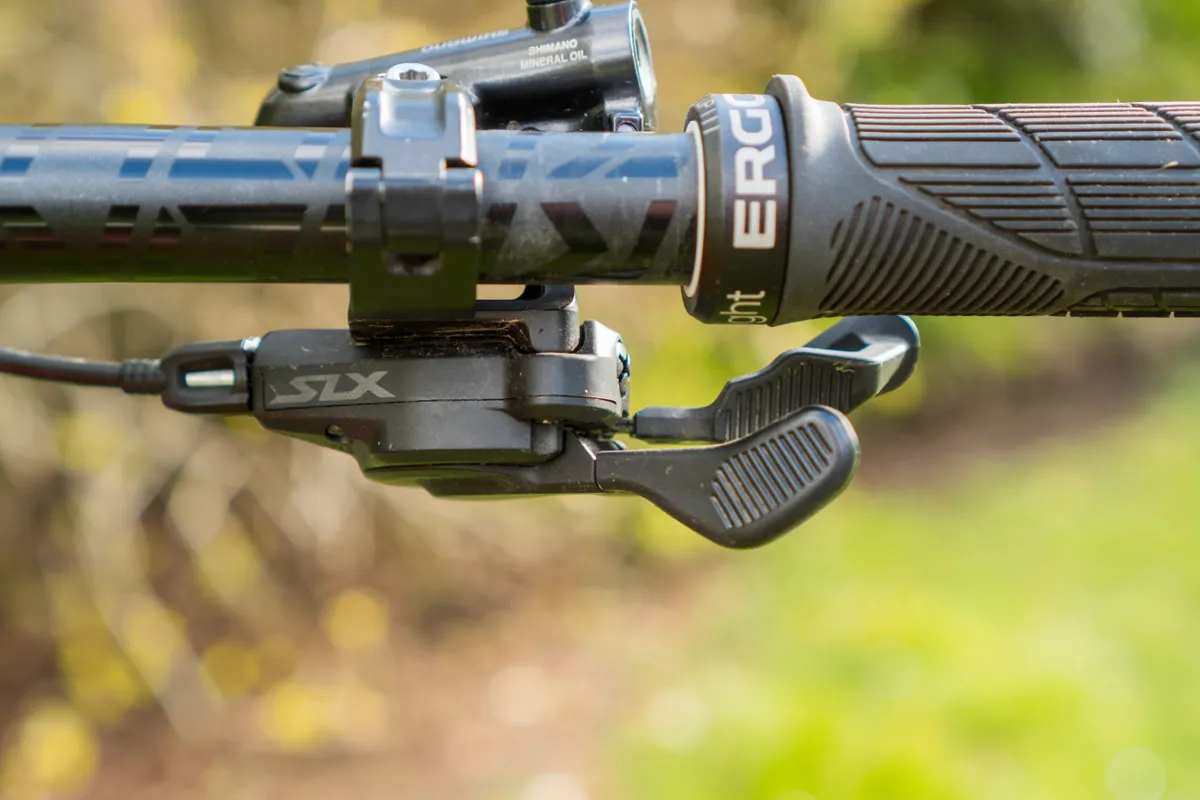
The SLX SL-M7100 shifter shares all of its technology with the cheaper 12-speed Deore SL-M6100 version.
This includes Rapidfire Plus, where three gears can be shifted with one push of the cable-pull lever, 2Way-Release where the cable-release lever can be operated in two directions by either the rider’s thumb or index finger and Shimano’s I-Spec EV that does away with the shifter’s dedicated bar clamp, which allows it to be integrated onto compatible brake lever clamps. Although bar clamp versions are also available.
Both cable-pull and release triggers have textured sections to aid grip and their shape and travel are identical to the rest of Shimano’s 12-speed shifters.
My test sample SLX SL-M7100-IR shifter weighed 133g including the factory-fitted inner gear cable.
Shimano SLX RD-M7100-SGS rear derailleur specifications
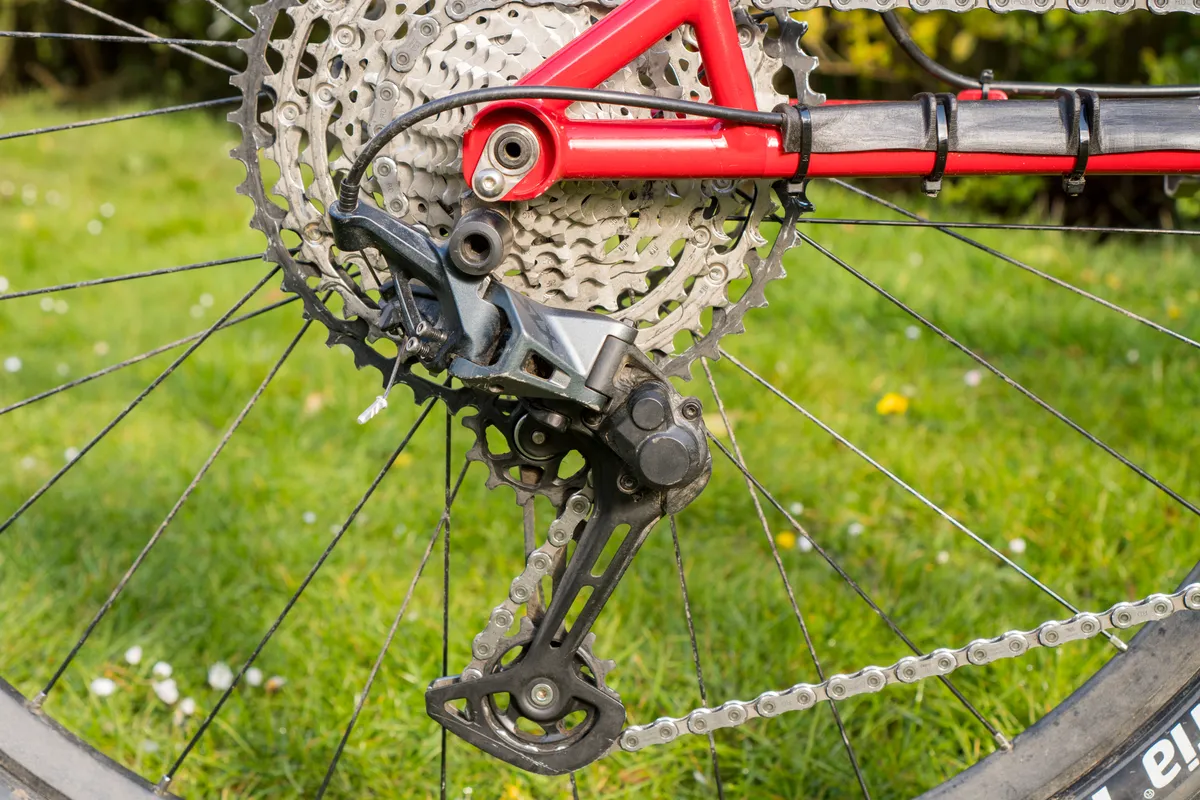
Like the shift lever, the RD-M7100-SGS rear derailleur also shares all of its specs with the more affordable Deore M6100 version. It uses Shimano’s Shadow RD+ design where the onboard on/off switchable and tension-adjustable clutch system controls the derailleur cage's movement.
The derailleur also has a low-profile design, where the cable clamp sits inboard of the derailleur’s knuckle – its widest point – and its shape means that knuckle-to-frame contact is impossible. While the cable stop faces vertically unlike SRAM’s horizontally positioned design.
Elsewhere, and just like the XT M8100 derailleur, there’s a small bumper attached to the top of the cage that Shimano claims “reduces impact shock by absorbing chain impact on aggressive terrain". However, the jockey wheels are shared with Shimano’s Deore M6100 model.
The derailleur is limited to a 10t smallest cassette sprocket and a 51t largest cassette sprocket.
My test sample SLX RD-M7100-SGS rear derailleur weighed 310g.
Shimano SLX CS-M7100-12 cassette and Shimano SLX CN-M7100 chain specifications
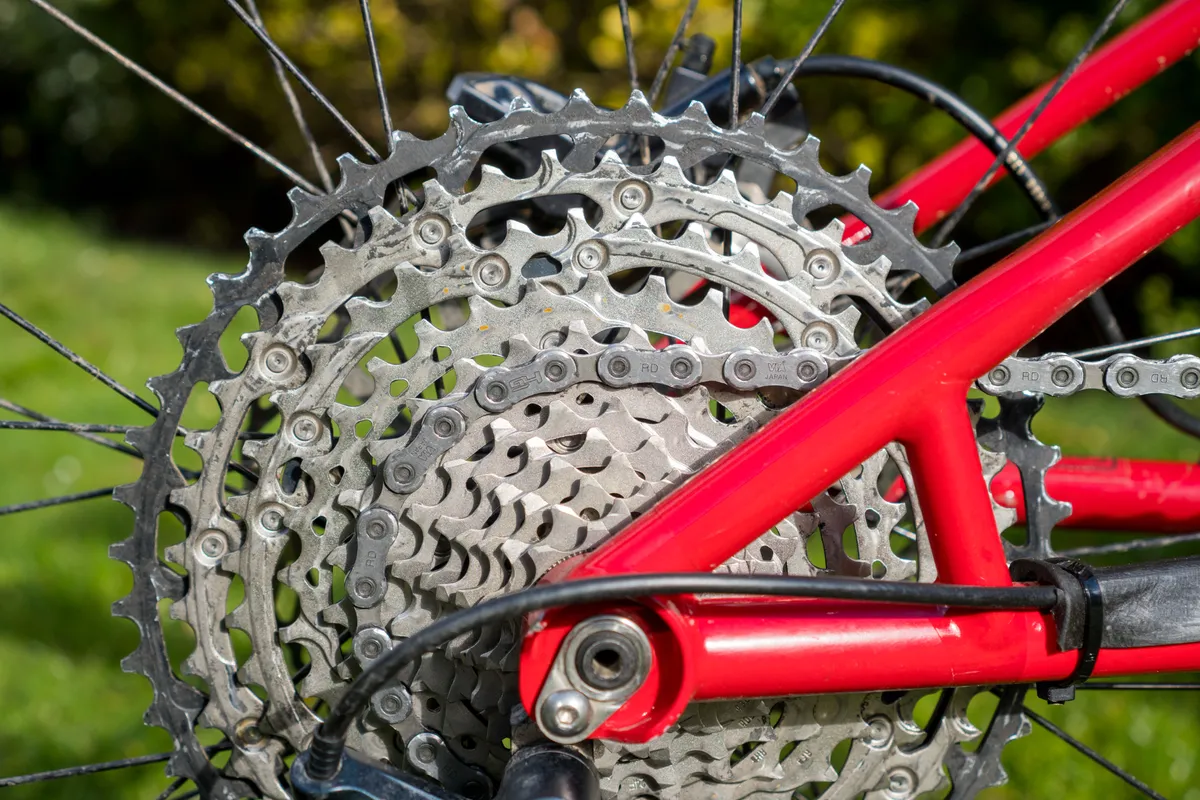
Like the rest of Shimano’s 12-speed cassettes, the SLX CS-M7100-12 uses its Micro Spline freehub standard that permits the use of a 10t highest sprocket.
It features an aluminium lowest 51t cassette sprocket, denoted by a black hardening treatment, while the remaining 11 cogs are steel. The seven largest cogs are attached to an aluminium spider – dubbed Beam Spider and is technology shared with Deore, XT and XTR – while the other five cogs are separate pieces.
Hyperglide+ technology also features. Thanks to shift ramps on the sides of the cassette sprockets, gear shifts can be under power. Teeth profiling also improves chain engagement and retention on the cassette. Shimano says Hyperglide+ technology is only compatible with Shimano chains, highlighting the need for a Shimano-branded chain.
The cassette is available in either a 10-45t range or a 10-51t range. Both options are 12-speed. The 10-51t range I tested has the following ratios: 10t, 12t, 14t, 16t, 18t, 21t, 24t, 28t, 33t, 39t, 45t and 51t.
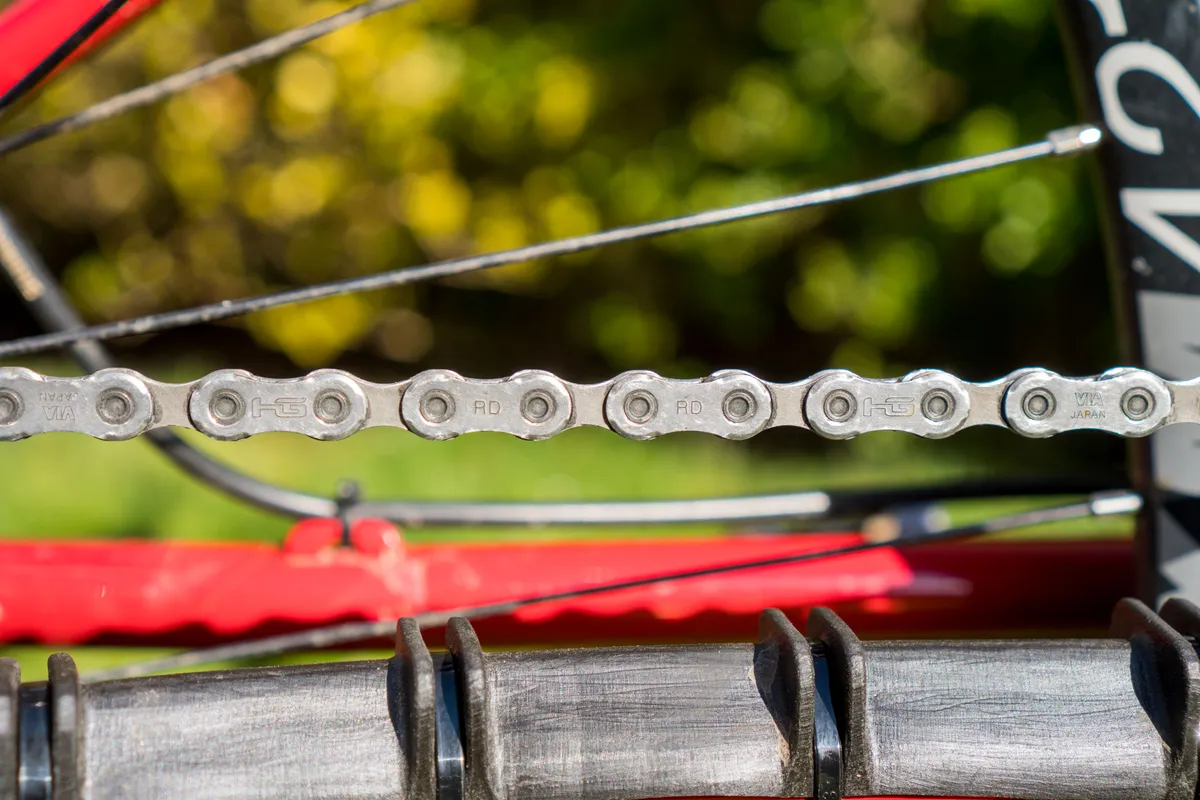
My SLX CS-M7100-12 10-51t cassette test sample weighed 521g on my scales.
The SLX CN-M7100-12 chain features Hyperglide+ tech and is compatible with DCE+ chainrings. The chain has been coated with Sil-Tec, Shimano’s low-friction treatment, which uses fluorine particles to repel contaminants and should make pedalling smoother, reduce maintenance and improve lifespans. The chain is joined using Shimano’s Quick-Link.
My SLX CN-M7100-12 116 link chain with quick link weighed 121g on my scales.
Shimano SLX M7100 groupset compatibility details
Shimano’s in-house technology, like Hyperglide+ and DCE+, is designed to work best with other Shimano components. Fortunately, all of Shimano’s 12-speed groupsets are inter-compatible. This means it is possible to pair SLX M7100 with other parts from the brand’s 12-speed offerings.
Astute purchasers should be able to balance cost, weight and performance for their own requirements without much hassle, while those looking for the complete SLX look can also do so. To definitively determine Shimano cross-groupset compatibility, please refer to its extensive compatibility charts.
Third-party components will and do work with Shimano kit, and this includes chains, cassettes, chainrings and pedal cranks. However, it is unlikely that the full benefits of the technology in Shimano’s kit will be available.
Because the cassette uses its Micro Spline freehub system, if you’re looking to purchase a 12-speed Shimano drivetrain (including SLX M7100), take care to make sure your existing rear hub's freehub – if it is an HG-style freehub or SRAM XD Driver version – can be changed or replaced. Factor in the cost of a new hub or freehub when purchasing SLX.
Be sure to verify whether your brake levers are I-Spec compatible or whether an I-Spec adaptor is available for them. Otherwise, take care to buy the bar clamp shifter lever because converting a bar clamp shifter to an I-Spec shifter isn’t recommended.
Shimano SLX M7100 groupset installation and setup
Fitting the SLX M7100 groupset to the bike requires the same processes and tools as the rest of Shimano’s 12-speed kit. Although there are no unusual steps, care needs to be taken in certain areas to make sure everything is installed correctly.
The chain needs to be installed as per Shimano’s instructions, where the stamped logos on the outer chain links are facing outwards and the quick link’s arrow faces the direction of the chain’s rotation. The chain also needs to be sized as per Shimano’s detailed instructions.
The cassette’s individual cog spacers are gear specific with different widths. This means incorrect spacer placement will stop the cassette from working.
Verifying the additional bottom bracket bearing seals are orientated correctly on the pedal cranks – while not crucial for operation – will extend the bearings’ lifespan. The correct orientation has the rubber seal facing the bottom bracket bearing rather than the pedal crank.
Removing or installing the chainring requires the (TL-FC41) tool. This is usually included with the pedal cranks (if bought aftermarket) or can be purchased for around £20.
Setting cable tension at the derailleur was easy, requiring no more than light tension. Indexing the gears was also simple and required only minor adjustments once the cable tension was set as above.

Setting the high and low limit screws correctly was also easy, but the 2mm Allen key heads make carrying out the process fiddly. Care needed to be taken to ensure solid engagement between the tool and Allen bolt. A larger Allen head bolt would improve the process.
The rear of the derailleur’s cage has a stamped mark for correct b-tension setup, where the mark needs to be lined up with the lowest point of the largest sprocket.
Setting b-tension incorrectly seemed to cause lazy shifting, but didn’t appear to reduce performance as much as incorrectly set b-tension does on SRAM’s systems. SLX M7100 also appeared to be less fussy about this setting compared to Deore M6100.
Not only is b-tension crucial for controlling shift performance it also dictates how taut the chain is in the cassette’s smallest sprocket, and how much length the chain has in the largest sprocket to compensate for suspension compression. Incorrect adjustment can result in a chain that appears too long or too short.
The derailleur’s adjustable and on/off switchable clutch meant wheel removal and installation was easy. Plus, the clutch’s lever has clear on/off lettering to avoid confusion about its position, unlike the Microshift Advent X derailleur.
The I-Spec shifter has plenty of side-to-side adjustment and was easy to set it to my preferred position and install onto my Shimano Deore BL-M6100 brakes.
Shimano SLX M7100 groupset performance
I tested the Shimano SLX M7100 groupset on several bikes including my Yeti SB165 long-term test bike and my personal Marin Alpine Trail XR.
I’ve put some incredibly gruelling kilometres on the groupset in a host of conditions from frozen-solid DH runs and axle-deep snow to gloopy mud bogs and dry and dusty hardpack trails all in Scotland’s Tweed Valley, home to the UK’s round of the Enduro World Series.
When this review was written, the groupset had covered over 1,110km of off-road riding and is still in use.
Shimano SLX RD-M7100-SGS rear derailleur performance

The derailleur’s factory-set clutch tension controlled chain slap impressively, limiting the amount of excess movement and helping keep noise to a minimum. This also meant the chain didn’t skip down the cassette when freewheeling over rough terrain regardless of which gear was selected prior to descending.
Its tension also stopped any gear skipping or jumping when pedalling hard over rough terrain. I didn't feel the need to increase clutch tension from the factory setting by using the adjuster, either. Arguably, SLX M7100’s clutch tension was higher than SRAM’s GX Eagle derailleur.
Along with the impressive chain control, the clutch’s tension didn’t stiffen the feel of the cable-pull lever, a problem I experienced on Box Component’s Box One Prime 9 derailleur. This meant I wasn’t struggling to balance chain control with shifter feel.

Changing gears while under power didn’t result in more resistance to get the derailleur to shift. Instead, it moved up and down the cassette smoothly and freely with no crunches or sneezes. This meant I was free to continue pedalling as hard as I wished while shifting without fear of damaging the system.
The only giveaway the derailleur was changing gear while under load was a slight increase in pressure through the pedal cranks as it pulled the chain across the cassette, but this was subtle enough to not be an issue.
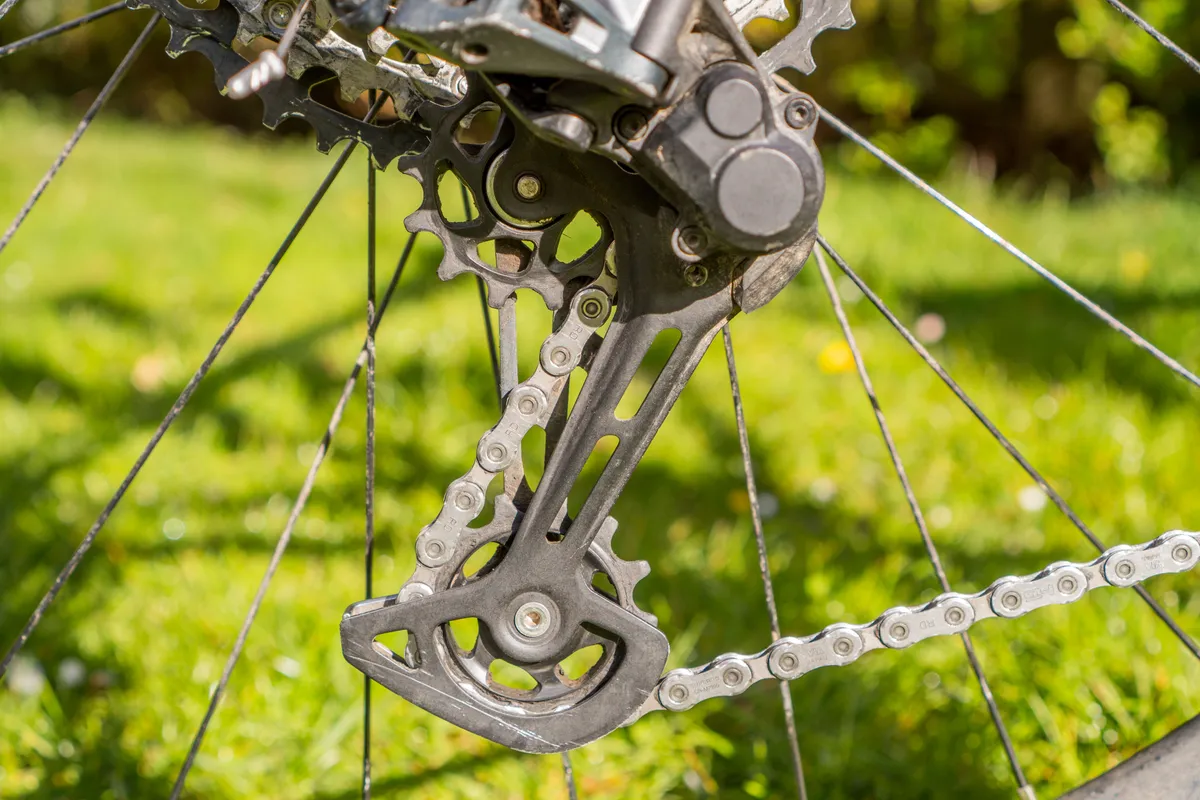
The derailleur remained damage-free during the test period and resisted knocks and bashes well. Its pivots and jockey wheels have remained wear-free as well, for the most part, only displaying signs of use rather than damage.
Despite its impressive performance, shifting wasn’t quite as smooth and slick as Shimano’s XT M8100 drivetrain and wasn’t a significant improvement over a well-setup Deore M6100 derailleur.
Shimano SLX SL-M7100-IR shifter performance
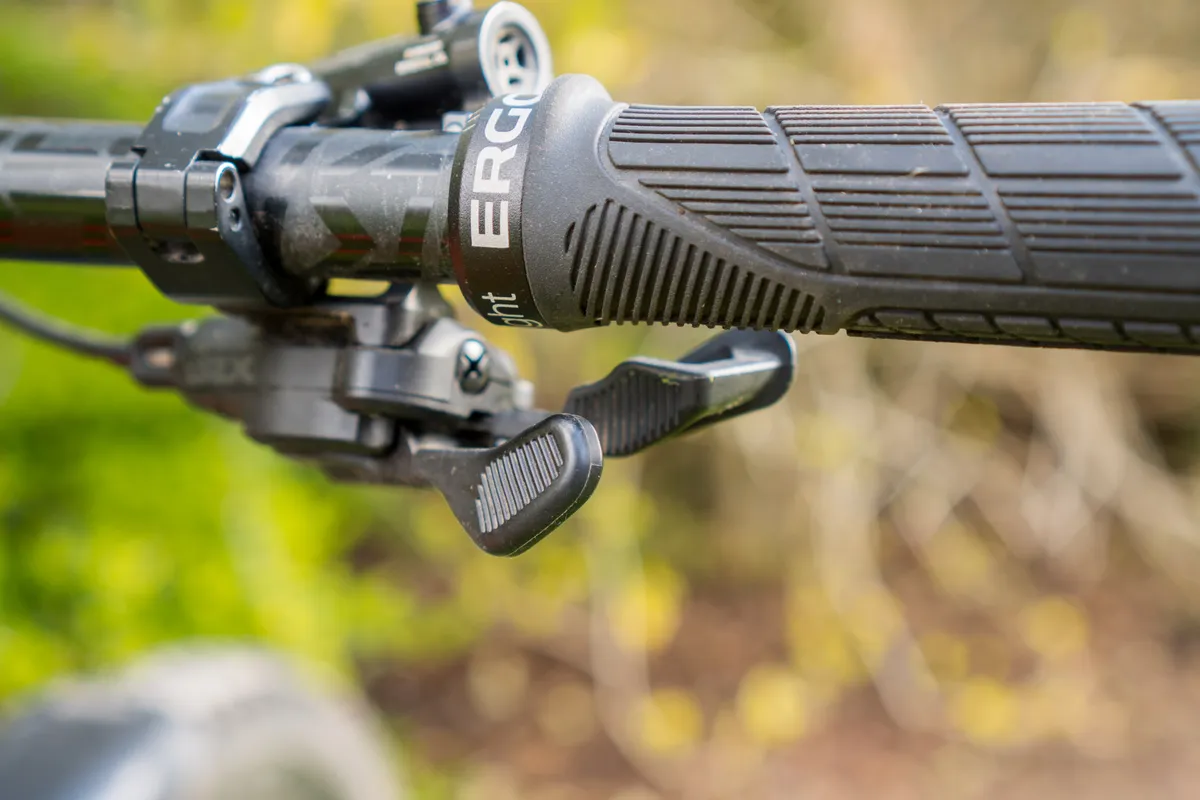
Thankfully the SLX SL-M7100 shifter’s excellent ergonomics are identical to Shimano’s other 12-speed kit. Better still, Shimano has perfected lever travel, position and shape and its I-Spec system makes setting the shifter to a comfortable position trouble-free.
The 3mm Allen key bolt that holds the shifter body to the I-Spec adaptor does require a long Allen key to loosen or tighten, however.
The shift levers feel fairly crisp and there’s a definitive click as each gear is selected. Shifting is a minor improvement over Deore M6100 but the depth of the shifter lever’s click isn’t as pronounced as Shimano’s M8100 XT, and the lever has to travel further, too. The longer-travel shift engagement makes shifts feel less accurate.
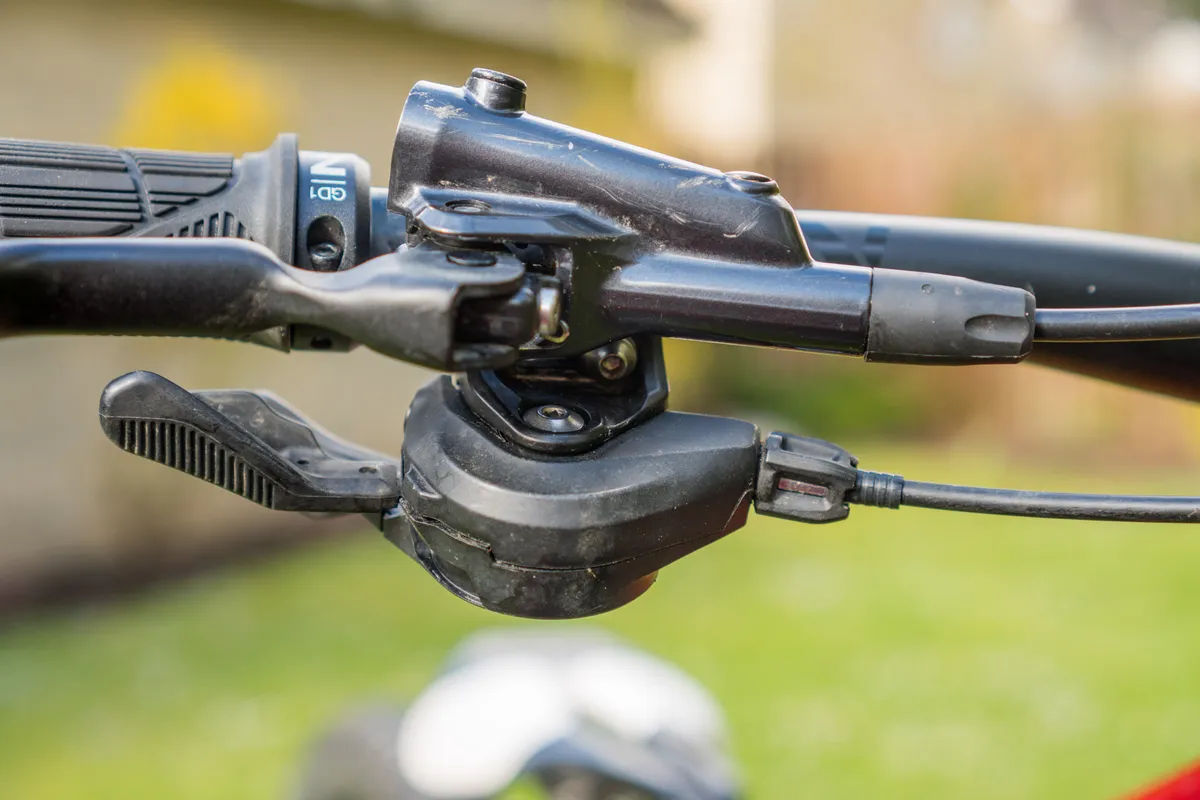
The 2Way-Release feature proved to be useful, but I did find myself missing the XT cable-release lever’s Multi-Release shifting where more than one higher gear can be shifted at once.
However, general shifting performance feels good, the cable-pull lever is light to operate and the mechanical connection between the derailleur and shifter – even when shifting under power – is well isolated from the rider. The cable-release lever’s changes are also well-defined.
Over time, shift degradation appeared to be very limited despite riding in plenty of adverse conditions. Shifter housing sealing is good and a change of gear cable restored as-new shifting performance.
SLX M7100’s shifting is best described as satisfyingly functional and reliable rather than premium. If you want premium-feeling shifting, upgrading to XT M8100 is a must.
Shimano SLX CS-M7100-12 cassette and Shimano SLX CN-M7100 chain performance
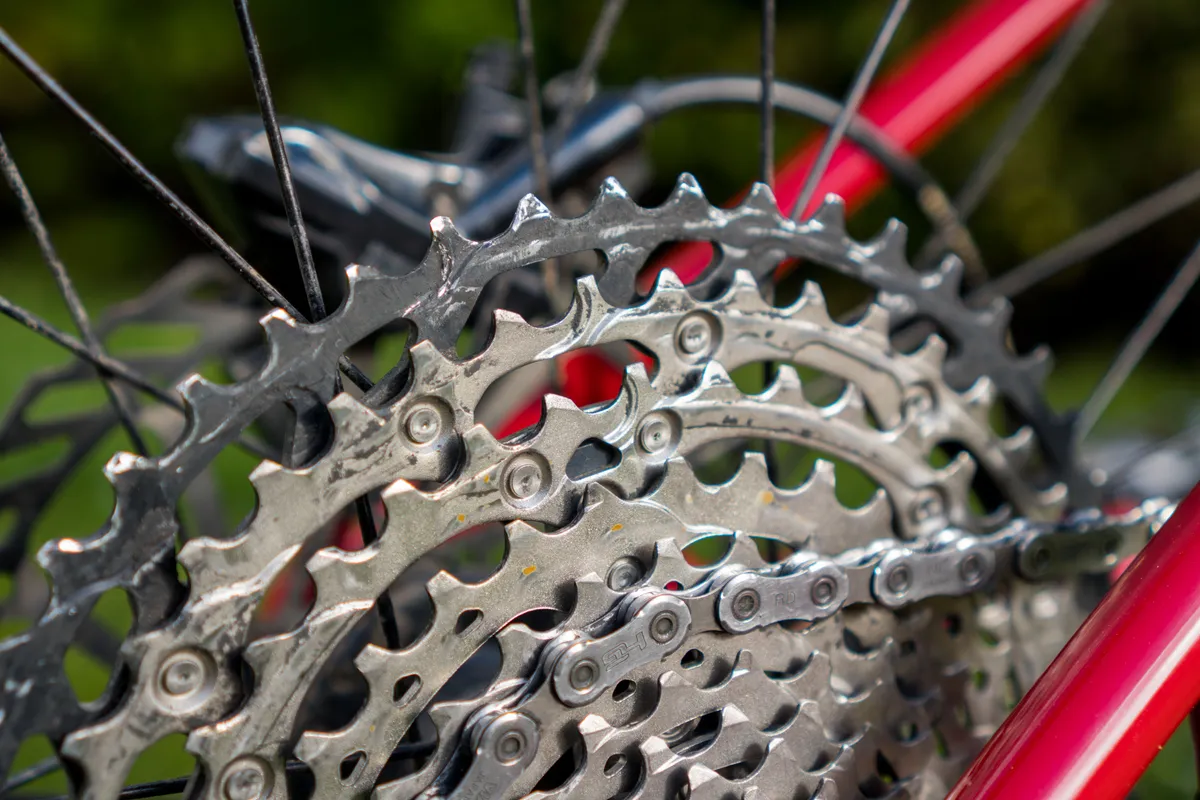
The cassette’s largest aluminium sprocket resisted wear well, its teeth not getting damaged or hooking. However, the black coating does show signs of wear as it has been worn by the chain.
The cassette’s steel sprockets haven’t become hooked or worn down and any rust that developed after storing the bike when it was wet was easy to remove with a quick clean. Cosmetics aside, the cassette still performs like new.
I found the steps between each of the sprockets to be well balanced, and each shift was met with a predictable change in speed or cadence. Because the largest sprockets are only separated by a maximum of 6t – rather than SRAM’s 10t – when changing between the top two gears less speed or cadence change is required to keep the bike moving at the same pace.
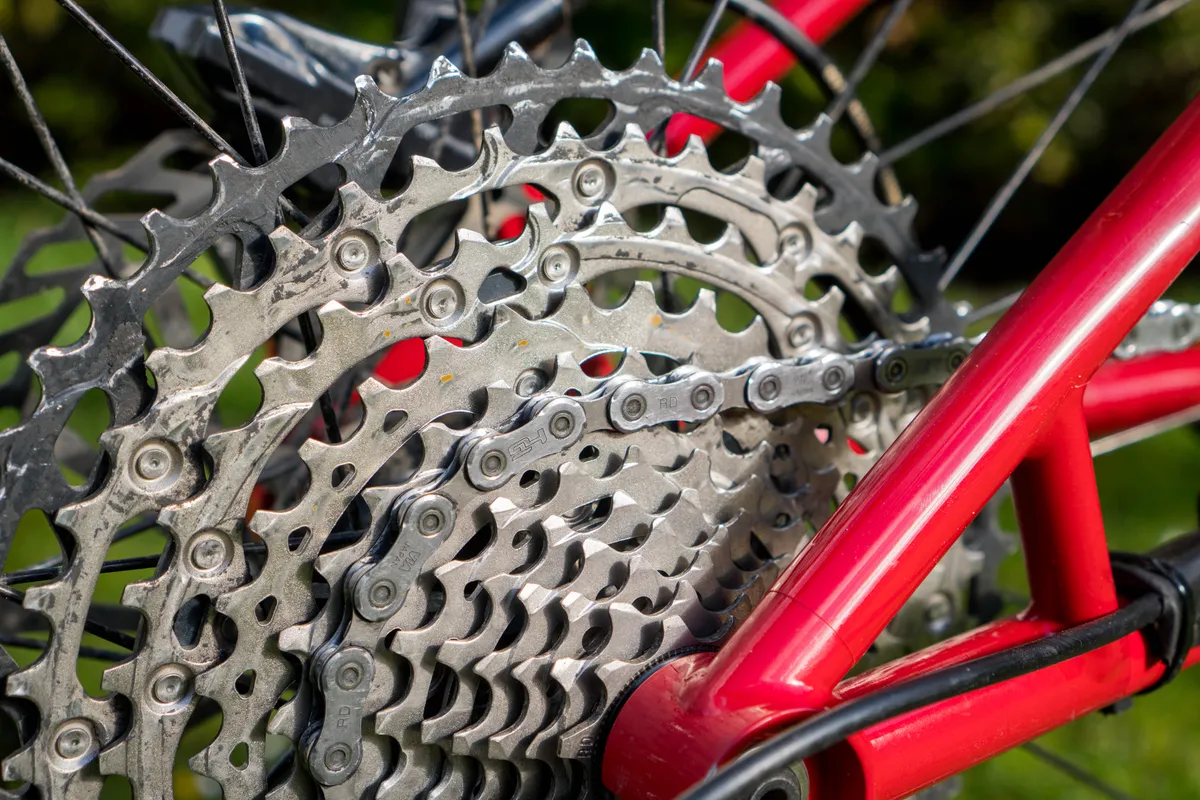
And because the jumps are smaller, I found myself using the 39t and 45t cassette sprockets more than I was expecting, relying on the 51t as a true bailout gear. As I’ve mentioned in other 12-speed Shimano reviews, I think Shimano has done a fantastic job with their gear ratios.
The chain resisted rust and general wear well. I found the SLX chain was more sensitive to lubrication and dried-on mud than the Deore and XT equivalents, though. When running a bit dry, it tended to suck around the chainring, where it remained hooked onto the chainring as it travelled off its bottom edge.
However, when lubricated well and cleaned rigorously, general running was quiet and felt incredibly smooth.
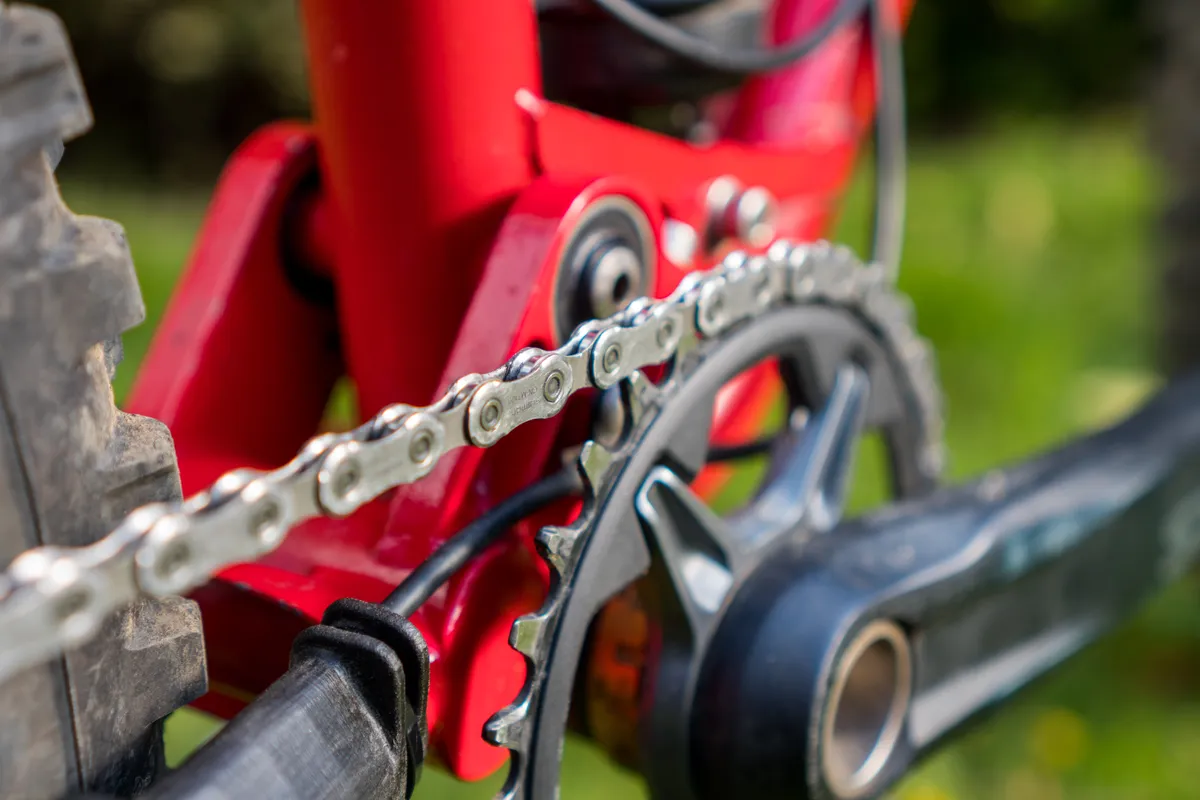
On power shifting, performance was also brilliant and as the chain was pushed up or down the cassette it didn’t hesitate to select the next gear and neither did it crunch or bang with any missed shifts.
Unlike the Deore M6100 and XT M8100, the SLX chain didn’t snap during the test period despite being subject to the same test conditions and maintenance routines.
Shimano SLX FC-M7120 crankset with SM-CRM75 32t chainring performance
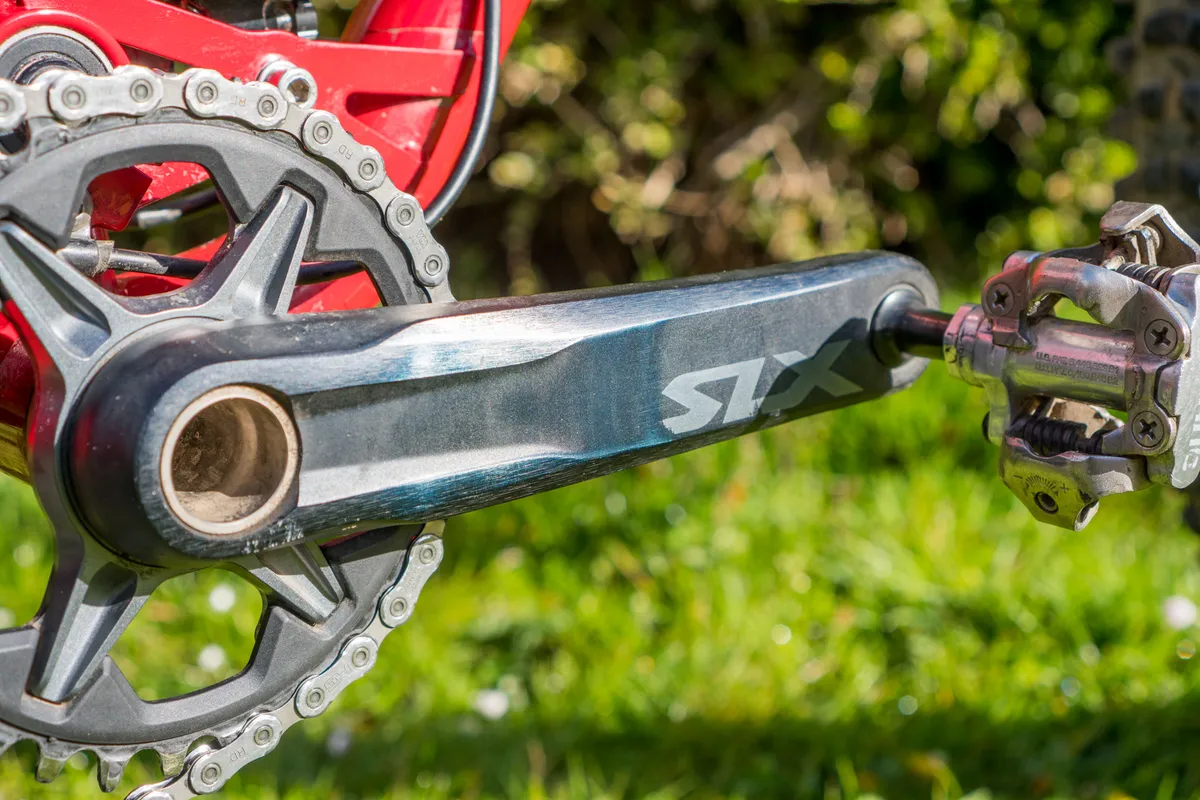
Cosmetically speaking, the SLX cranks fared as well as Deore and XT, their finish getting rubbed off within the first few damp rides. This issue could be mitigated by brands offering a pre-polished silver version of their cranks with no finish.
SPD pedal users might suffer less from this issue, especially if their shoes are set with minimal float. The cranks pictured have been ridden by an SPD rider for the duration of their life (approximately 1,000km of off-road riding) and their finish has retained its colour better than the test sample I used.
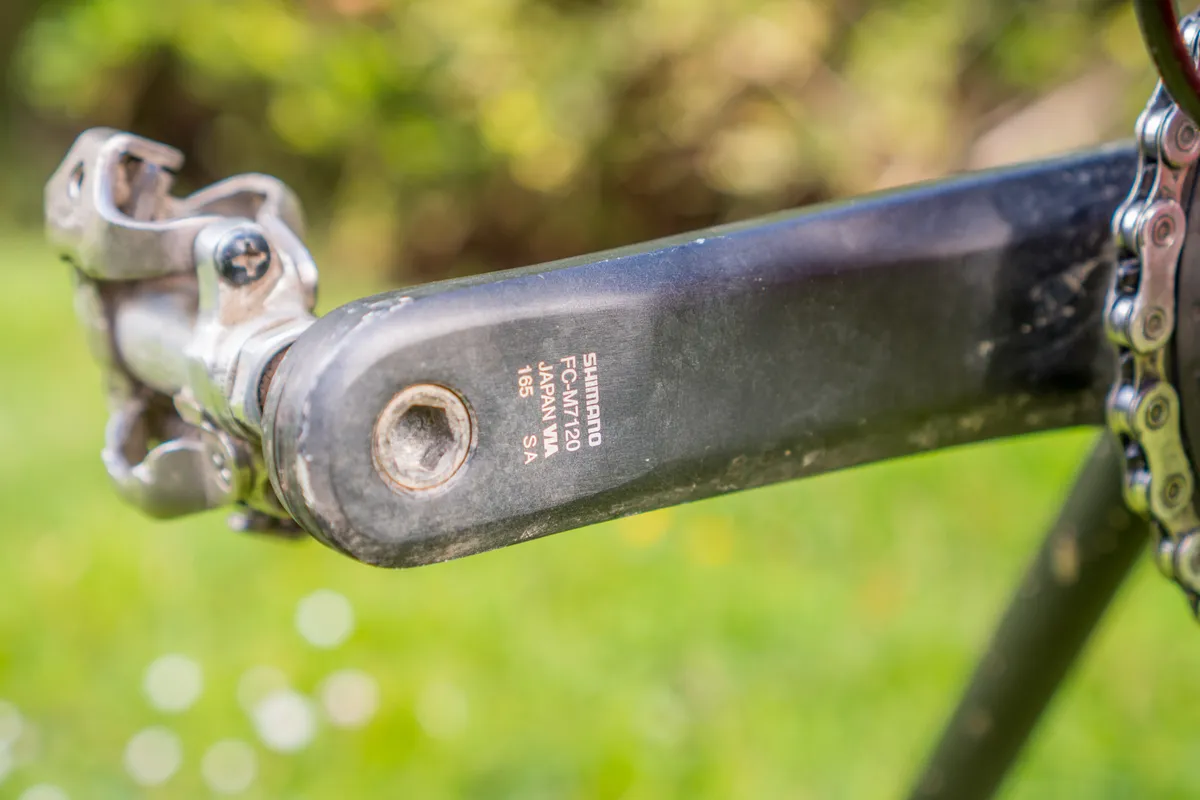
From a performance perspective, the cranks have remained unchanged despite suffering several hard blows by flying stones and getting bashed into immovable rocks.
The chainring has remained hook- and damage-free, too, although the black coating of the teeth has worn away entirely on the outside face of the ring.

During the test period, I didn’t suffer from a single dropped chain despite not having a chain device fitted. This is testimony to the chain and chainring’s compatibility and performance.
How does Shimano SLX M7100 compare to SRAM NX Eagle and GX Eagle and Shimano Deore and XT?
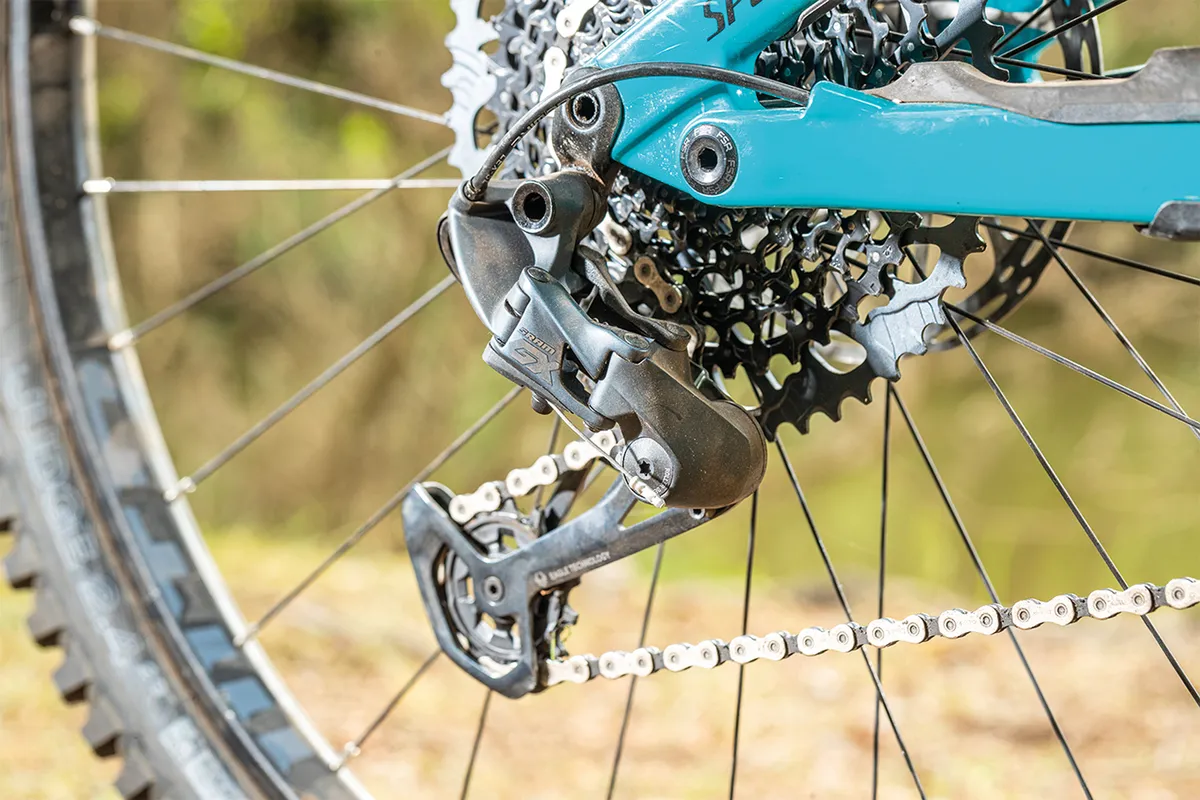
Shimano SLX M7100's most obvious direct SRAM 12-speed competitor is NX Eagle, given it also sits one up from the bottom of the brand’s 12-speed hierarchy.
Weight-wise, however, SLX M7100 is closer to SRAM’s GX Eagle, tipping the scales at just 14g heavier in a like-for-like comparison. Compared to NX Eagle, SLX M7100 is 184g lighter.
The cost of each groupset muddies the waters further. SLX is roughly £100 / $150 less than GX Eagle and is roughly £40 / $40 more expensive than NX Eagle. This positions it somewhere between NX Eagle and GX Eagle in terms of cost and weight.
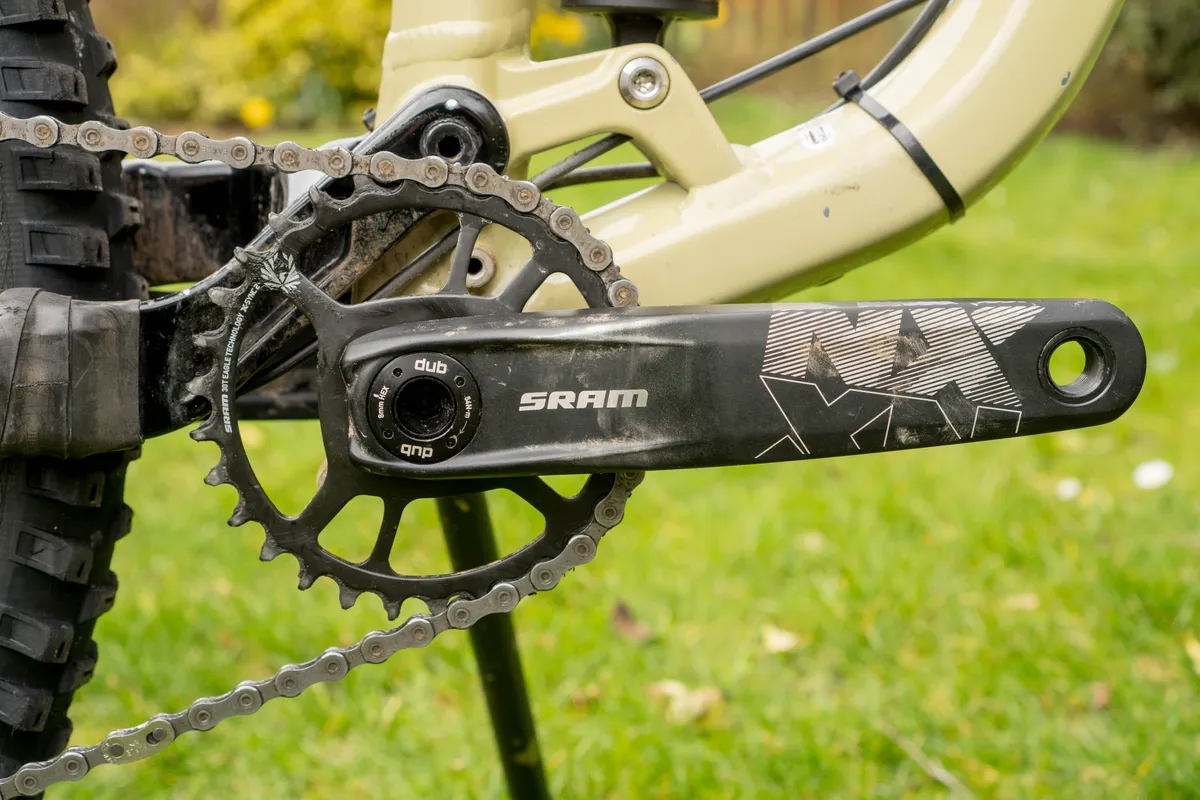
However, SLX’s performance, build quality and feel is leagues ahead of NX Eagle, especially its on-power shifting and ease of setup. Also, the derailleur’s bushings and pins do not have play from the factory, furthering SLX’s lead.
This means SLX’s performance is on par with GX Eagle in all but shifter feel and weight, where GX Eagle just edges ahead. Comparing it to a groupset that’s substantially more expensive could be unfair, but SLX M7100 puts up an impressive fight. Given a choice between GX Eagle and SLX M7100, it would be tricky to make a definitive decision.
SRAM’s NX Eagle uses a standard Shimano HG freehub body for its cassette, so represents a cheaper way to upgrade to 12 gears from 9, 10 or 11 speeds compared to SLX. However, stretching to the Shimano Micro Spline freehub system rewards you with fantastically and evenly spaced gears, something that SRAM’s current cassettes, in my opinion, don’t offer.
Compared to Shimano’s Deore M6100, SLX doesn’t offer a significant improvement in feel or shift performance. Despite it being 155g lighter, I don’t feel the £113 / $100 / AU$150 hike up in price is worth it.
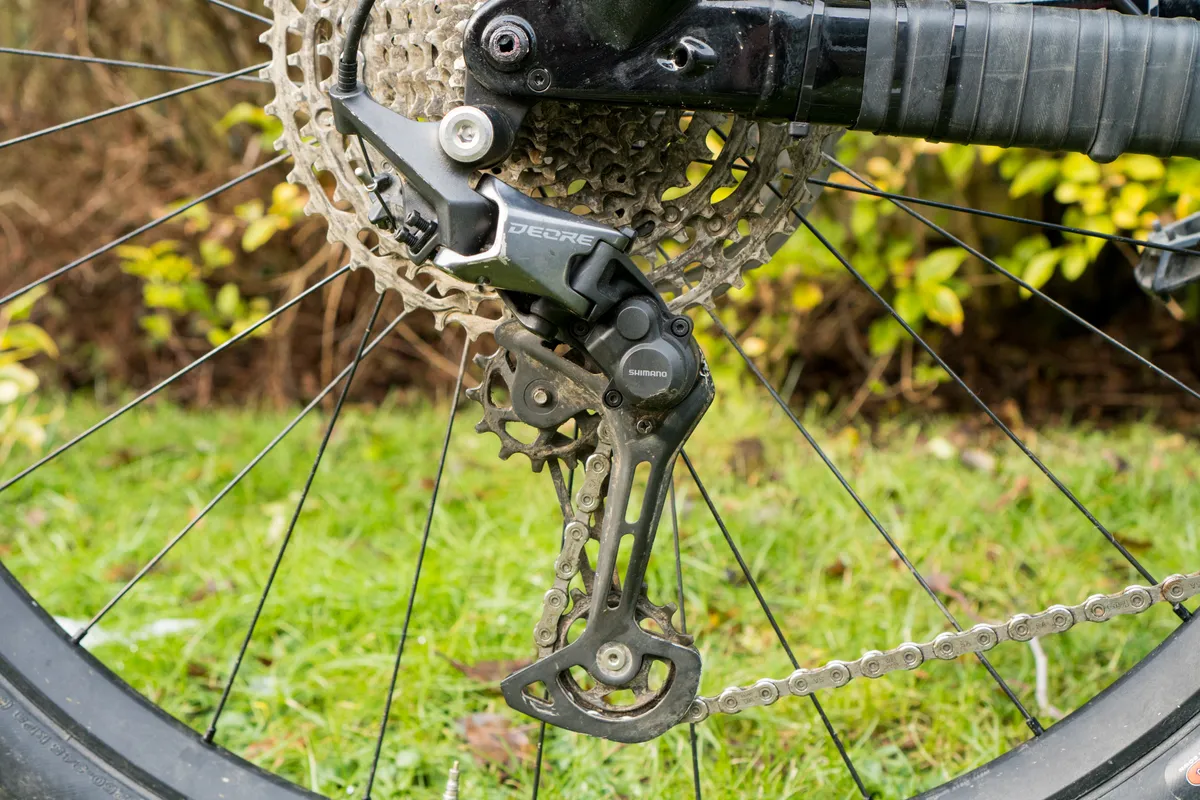
Shifting feels marginally more precise than M6100, but not enough to warrant such an increase alone.
Even combined with a 155g drop in weight, it’s still not worth the extra cash in my opinion.
Compared to XT M8100, however, there is a big difference. SLX M7100 feels much closer to Deore M6100 than I expected and, despite it not being much heavier than XT M8100 (only 41g), it’s worth the additional £168 / $217 / AU$409 if you can stretch that far.

Of course, there is a cheat's way to get quasi-XT M8100 performance on a Deore M6100 or SLX M7100 groupset. Simply swapping out either range’s shifter for the XT M8100 version will drastically improve their overall feel. This is the most cost-effective way to access the best-feeling performance Shimano has to offer.
Shimano SLX M7100 groupset bottom line
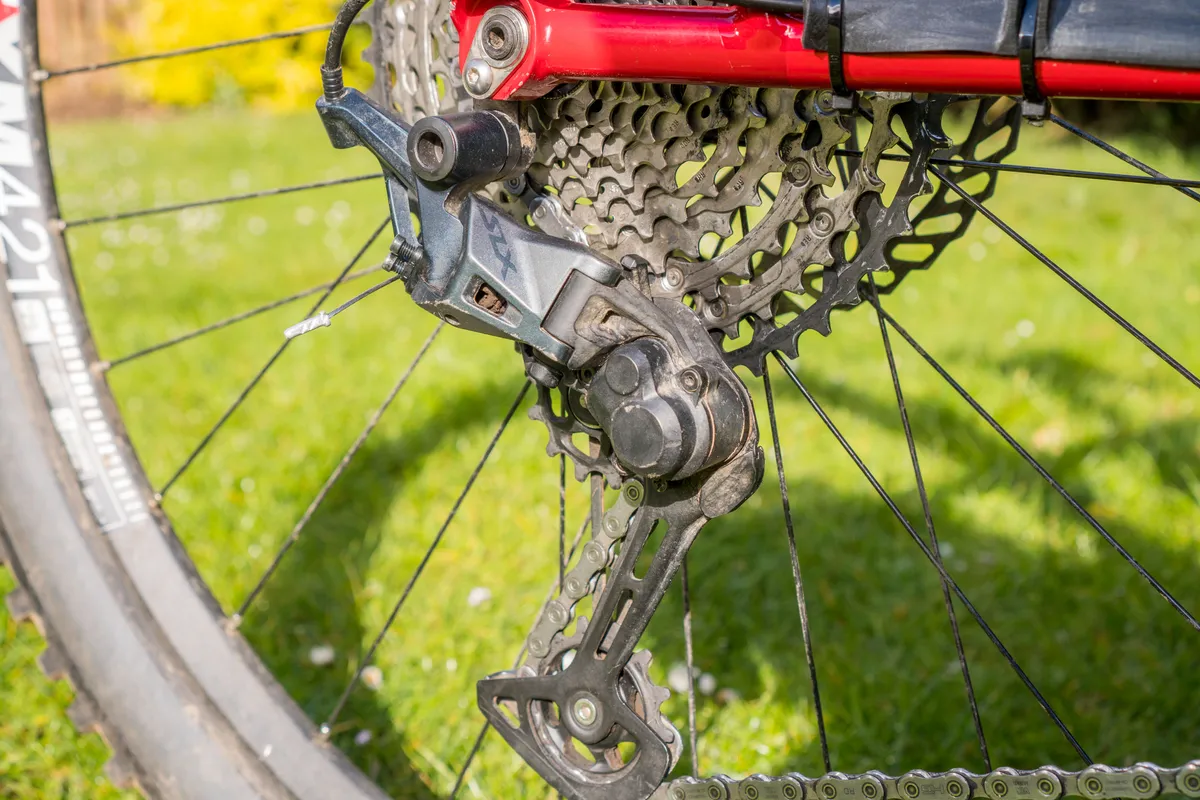
Although SLX M7100 is feature-packed and has impressively reliable performance, it lacks any significant improvements in feel or technology over Deore M6100.
It is 155g lighter, but the £1.37 or $1.50 per gram of weight-saving over Deore is hard to justify. Like Deore M6100, SLX M7100 would benefit from an XT M8100 shifter upgrade. This is a cost-effective way to access next-level feel without the price.
SLX M7100 feels great out on the trails and has proven itself in some of the toughest conditions I could throw its way, it’s just a shame the step up from Deore to SLX isn’t substantial enough to warrant the cost.
Product
| Brand | Shimano |
| Price | A$734.00, £398.94, $394.94 |
| Weight | 1864g |
| br_whatWeTested | Shimano SLX M7100 groupset |
Features
| Crank options | 1x |
| Speed | 12 |
| Cassette options | 10-45t, 10-51t (10t, 12t, 14t, 16t, 18t, 21t, 24t, 28t, 33t, 39t, 45t and 51t) |
| Chainring options | 30t, 32t, 34t |
